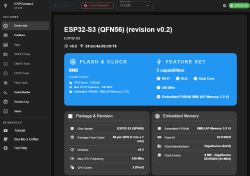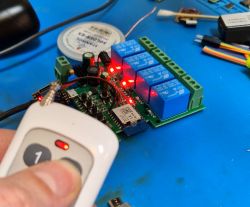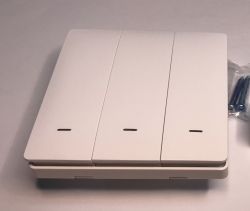Hello, everyone.
I am just starting my adventure with Home Assistant.
I want to integrate my room panel (thermostat) into the HA and to be honest I don't know how to go about it. I've tried to find something on the web, but I'm having a poor time.
The manufacturer gives this information:
The R WiFi remote control is not an internet module however it allows communication in the local network with the possibility of redirection to the outside (depends on the conditions of the internet provider). In addition, it has the ability to send real-time data to a server and view them on www.aplikacja.prond.pl/pilotWifi 8 This makes the WiFi Pilot a functional device for remote monitoring of temperatures and the operating status of equipment in the boiler room.
For developers:
Pilot R WiFi transmits data to the browser in JSON format, which advanced users can use in their own control projects (smart building, etc.). Details are described in the appendix for programmers.
Appendix for developers
The Pilot R WiFi module can be communicated with via the network using queries of
HTML. The queries should be sent to: [ip address PilotR]/main . The data is sent in
JSON format. Examples for javascript.
Reading parameters from PilotR
var xh = new XMLHttpRequest();
xh.onreadystatechange = function () {
if (xh.readyState == 4) {
if (xh.status == 200) {
var res = JSON.parse(xh.responseText);
//here „res” contains all read parameters
};
xh.open(“GET”, “/main”, true);
xh.send(null);
Example response:
{“t_kot”:21.8, “t_pok”:20.9, “outputs”:0, “status”:0, “alarm”:0, “n_kotmin”:35, “n_kotmax”:85,
“n_reg”:55, “t_mix”:0, “t_pog”:-128, “t_cwu”:0, “opal”:0, “n_kot”:55, “n_cwu”:0, “signal”:-85,
“n_mix”:0, “n_pok”:23.6, “hist”:0.2, “c_odpomp”:10, “downgrade”:0, “sound”:3, “dod_al”:96,
“c_zalpomp”:60, “data”:“30.03.2020”, “czas”:“15:09:13”}
Meaning of parameters:
t_kot – boiler/circuit temperature 0 - 99.9 (100 means exceeding the range)
t_pok – room temperature -9.9 – 60.0 (280.5 means failure of PilotR sensor)
outputs – status of controller outputs (0 –off or none, 1 – on):
bit 0 – pump 3
bit 1 – blower 2
bit 2 – not used
bit 3 – blower
bit 4 – central heating pump
bit 5 – DHW pump
bit 6 – feeder
bit 7 – blower (on fan 1)
status – operation status and other markers:
bit 0 – 0-nothing 1-signal of missing fuel (this is not AL5)
bit 1 – 0-pilot operates 1-pilot extinguishes display
bit 2 – indication of reaching the preset temperature (blinking dot) 0-calculated from
setpoint and boiler temp. 1-status bit 3
bit 3 – blinking dot: 0 - off, 1 - on
bit 4 – HUW priority: 0-not active, 1-active
bit 7,6,5 – operating status:
000 – no status (controller not sending)
001 – stop
010 – firing up
011 – operating
100 – holding
101 – manual operation
110 – positioning
111 – not used
bit 8 – 0-room control 1-boiler/circuit control
bit 9 – no connection between pilotR and controller (e.g. defective cable)
alarm – 0 –no alarm other values 0x01-0x0f are the displayed alarm number
n_kotmin – minimum boiler setting allowed by the regulator
n_kotmax – maximum boiler setting allowed by regulator
n_reg – setting for the regulator calculated from the formula n_kot-obnuska (used in older regulators, here only
used in older regulators, here only for information)
t_mix – mixer temperature
t_pog – temperature of the weather sensor (from the regulator)
t_cwu – DHW temperature
opal – fuel level 0-no data 1-101 = 0-100%
n_kot – boiler setting
n_cwu – HUW setting 0-no data or HUW off, 15-75
signal – wifi signal level -127-0
n_mix – setting mixer 0-no data
n_pok – room temp. setting 1.0-50.0 in 0.2 steps
hist – room hysteresis 0.1-5.0 in 0.1 steps
c_dpump – pump off time 0-91
lowering – lowering set point 0-99
sound – indication 0-3
add_al – additional alarm 30-95, 96=off
c_zalpomp – pump activation time 10-99
date – date calculated by PilotR
time - time counted by PilotR
Sending parameters to PilotR
var xh = new XMLHttpRequest();
xh.open(“POST”, “/main”, true);
xh.send("{“n_pok”:22.0}");
Variables handled by PilotR:
n_kot – boiler setting - integer in the range n_kotmin – n_kotmax
n_cwu – HUW setting - integer from the interval 15-75
n_pok – room temp. setting – float variable with 1 decimal place in the range
in the range 1.0-50.0
hist – hysteresis for the room – float variable with 1 decimal place in the interval 1.0-5.0
interval 1.0-5.0
c_pump – pump off time 0-91, where 0=on permanently, 91=
permanently disabled (no cyclic pumping)
decrease – setting decrease 0-99
sound – signalling 0-3
dod_al – additional alarm 30-96, 96=disabled
c_zalpomp – pump activation time 10-99
command – functions – variable of string type:
rudder – change of control mode in PilotR (room<->boiler)
status – changing the operation status of the boiler controller (operation<->stop)
config – saving PilotR configuration to EEPROM memory
Parameters can be sent separately or in multiples, it is not recommended to send
unnecessary parameters, i.e. those that have not changed.
Attention !!!
Sending settings related to PilotR i.e.: hist, c_odpomp, obnizka, sound,
dod_al, c_zalpomp causes their temporary change (until power off).
Permanent saving is made by sending the command ‘config’. Other settings and
commands are immediately written to the controller or PilotR memory after approval.
As the EEPROM memory has a finite number of entries, it is not possible to use
these parameters for a smooth control of e.g. the set boiler temperature. For this purpose
This is also why limits of up to 25 changes per day have been introduced, counted separately for each parameter.
parameter. This is sufficient for time-based control every hour. For stepless control of the
The boiler setting can be reduced by setting the room control accordingly.
room control.
I am just starting my adventure with Home Assistant.
I want to integrate my room panel (thermostat) into the HA and to be honest I don't know how to go about it. I've tried to find something on the web, but I'm having a poor time.
The manufacturer gives this information:
The R WiFi remote control is not an internet module however it allows communication in the local network with the possibility of redirection to the outside (depends on the conditions of the internet provider). In addition, it has the ability to send real-time data to a server and view them on www.aplikacja.prond.pl/pilotWifi 8 This makes the WiFi Pilot a functional device for remote monitoring of temperatures and the operating status of equipment in the boiler room.
For developers:
Pilot R WiFi transmits data to the browser in JSON format, which advanced users can use in their own control projects (smart building, etc.). Details are described in the appendix for programmers.
Appendix for developers
The Pilot R WiFi module can be communicated with via the network using queries of
HTML. The queries should be sent to: [ip address PilotR]/main . The data is sent in
JSON format. Examples for javascript.
Reading parameters from PilotR
var xh = new XMLHttpRequest();
xh.onreadystatechange = function () {
if (xh.readyState == 4) {
if (xh.status == 200) {
var res = JSON.parse(xh.responseText);
//here „res” contains all read parameters
};
xh.open(“GET”, “/main”, true);
xh.send(null);
Example response:
{“t_kot”:21.8, “t_pok”:20.9, “outputs”:0, “status”:0, “alarm”:0, “n_kotmin”:35, “n_kotmax”:85,
“n_reg”:55, “t_mix”:0, “t_pog”:-128, “t_cwu”:0, “opal”:0, “n_kot”:55, “n_cwu”:0, “signal”:-85,
“n_mix”:0, “n_pok”:23.6, “hist”:0.2, “c_odpomp”:10, “downgrade”:0, “sound”:3, “dod_al”:96,
“c_zalpomp”:60, “data”:“30.03.2020”, “czas”:“15:09:13”}
Meaning of parameters:
t_kot – boiler/circuit temperature 0 - 99.9 (100 means exceeding the range)
t_pok – room temperature -9.9 – 60.0 (280.5 means failure of PilotR sensor)
outputs – status of controller outputs (0 –off or none, 1 – on):
bit 0 – pump 3
bit 1 – blower 2
bit 2 – not used
bit 3 – blower
bit 4 – central heating pump
bit 5 – DHW pump
bit 6 – feeder
bit 7 – blower (on fan 1)
status – operation status and other markers:
bit 0 – 0-nothing 1-signal of missing fuel (this is not AL5)
bit 1 – 0-pilot operates 1-pilot extinguishes display
bit 2 – indication of reaching the preset temperature (blinking dot) 0-calculated from
setpoint and boiler temp. 1-status bit 3
bit 3 – blinking dot: 0 - off, 1 - on
bit 4 – HUW priority: 0-not active, 1-active
bit 7,6,5 – operating status:
000 – no status (controller not sending)
001 – stop
010 – firing up
011 – operating
100 – holding
101 – manual operation
110 – positioning
111 – not used
bit 8 – 0-room control 1-boiler/circuit control
bit 9 – no connection between pilotR and controller (e.g. defective cable)
alarm – 0 –no alarm other values 0x01-0x0f are the displayed alarm number
n_kotmin – minimum boiler setting allowed by the regulator
n_kotmax – maximum boiler setting allowed by regulator
n_reg – setting for the regulator calculated from the formula n_kot-obnuska (used in older regulators, here only
used in older regulators, here only for information)
t_mix – mixer temperature
t_pog – temperature of the weather sensor (from the regulator)
t_cwu – DHW temperature
opal – fuel level 0-no data 1-101 = 0-100%
n_kot – boiler setting
n_cwu – HUW setting 0-no data or HUW off, 15-75
signal – wifi signal level -127-0
n_mix – setting mixer 0-no data
n_pok – room temp. setting 1.0-50.0 in 0.2 steps
hist – room hysteresis 0.1-5.0 in 0.1 steps
c_dpump – pump off time 0-91
lowering – lowering set point 0-99
sound – indication 0-3
add_al – additional alarm 30-95, 96=off
c_zalpomp – pump activation time 10-99
date – date calculated by PilotR
time - time counted by PilotR
Sending parameters to PilotR
var xh = new XMLHttpRequest();
xh.open(“POST”, “/main”, true);
xh.send("{“n_pok”:22.0}");
Variables handled by PilotR:
n_kot – boiler setting - integer in the range n_kotmin – n_kotmax
n_cwu – HUW setting - integer from the interval 15-75
n_pok – room temp. setting – float variable with 1 decimal place in the range
in the range 1.0-50.0
hist – hysteresis for the room – float variable with 1 decimal place in the interval 1.0-5.0
interval 1.0-5.0
c_pump – pump off time 0-91, where 0=on permanently, 91=
permanently disabled (no cyclic pumping)
decrease – setting decrease 0-99
sound – signalling 0-3
dod_al – additional alarm 30-96, 96=disabled
c_zalpomp – pump activation time 10-99
command – functions – variable of string type:
rudder – change of control mode in PilotR (room<->boiler)
status – changing the operation status of the boiler controller (operation<->stop)
config – saving PilotR configuration to EEPROM memory
Parameters can be sent separately or in multiples, it is not recommended to send
unnecessary parameters, i.e. those that have not changed.
Attention !!!
Sending settings related to PilotR i.e.: hist, c_odpomp, obnizka, sound,
dod_al, c_zalpomp causes their temporary change (until power off).
Permanent saving is made by sending the command ‘config’. Other settings and
commands are immediately written to the controller or PilotR memory after approval.
As the EEPROM memory has a finite number of entries, it is not possible to use
these parameters for a smooth control of e.g. the set boiler temperature. For this purpose
This is also why limits of up to 25 changes per day have been introduced, counted separately for each parameter.
parameter. This is sufficient for time-based control every hour. For stepless control of the
The boiler setting can be reduced by setting the room control accordingly.
room control.







